Mingyue Mountain: The Perfect Destination for Nature Lovers and History Buffs
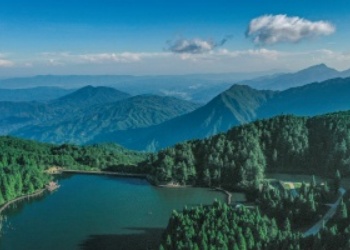
An Essential Guide to Visiting Mingyue Mountain
In This Guide
- An Essential Guide to Visiting Mingyue Mountain
- The Rich History and Legends of Mingyue Mountain
- Main Highlights: What You Absolutely Can’t Miss
- Planning Your Visit: A Practical Guide
- Tickets: Prices, Booking, and Tips
- How to Get There: A Complete Transportation Guide
- Local Cuisine and Accommodation Nearby
- Frequently Asked Questions
- Final Thoughts on Your Trip
Visiting Mingyue Mountain is akin to stepping into a living tapestry of natural beauty, rich history, and cultural significance. Nestled in Jiangxi Province, this breathtaking destination rises majestically with its twelve peaks, including the formidable Taiping Mountain, which stands at an impressive 1,735.6 meters. The mountain’s unique crescent shape, reminiscent of a half-moon, lends it an enchanting allure, making it a haven for nature lovers, adventurers, and those seeking a deep dive into China’s spiritual heritage.
As you traverse the well-preserved trails, you’ll discover a landscape that is as diverse as it is captivating. The Qingyun Trail, one of China’s most thrilling suspended walkways, offers an exhilarating journey through lush forests and panoramic views that will leave you breathless. Make sure to visit Moon Lake, a serene spot steeped in local legend, where you can unwind amid the stunning scenery that surrounds you.
Mingyue Mountain is not only a feast for the eyes; it is a site of deep-rooted cultural significance. With its array of Buddhist and Taoist temples, visitors can immerse themselves in the spiritual essence that has attracted pilgrims for centuries. The area is also renowned for its natural hot springs, particularly the Wentang Hot Spring, which promises a rejuvenating experience after a day of exploration.
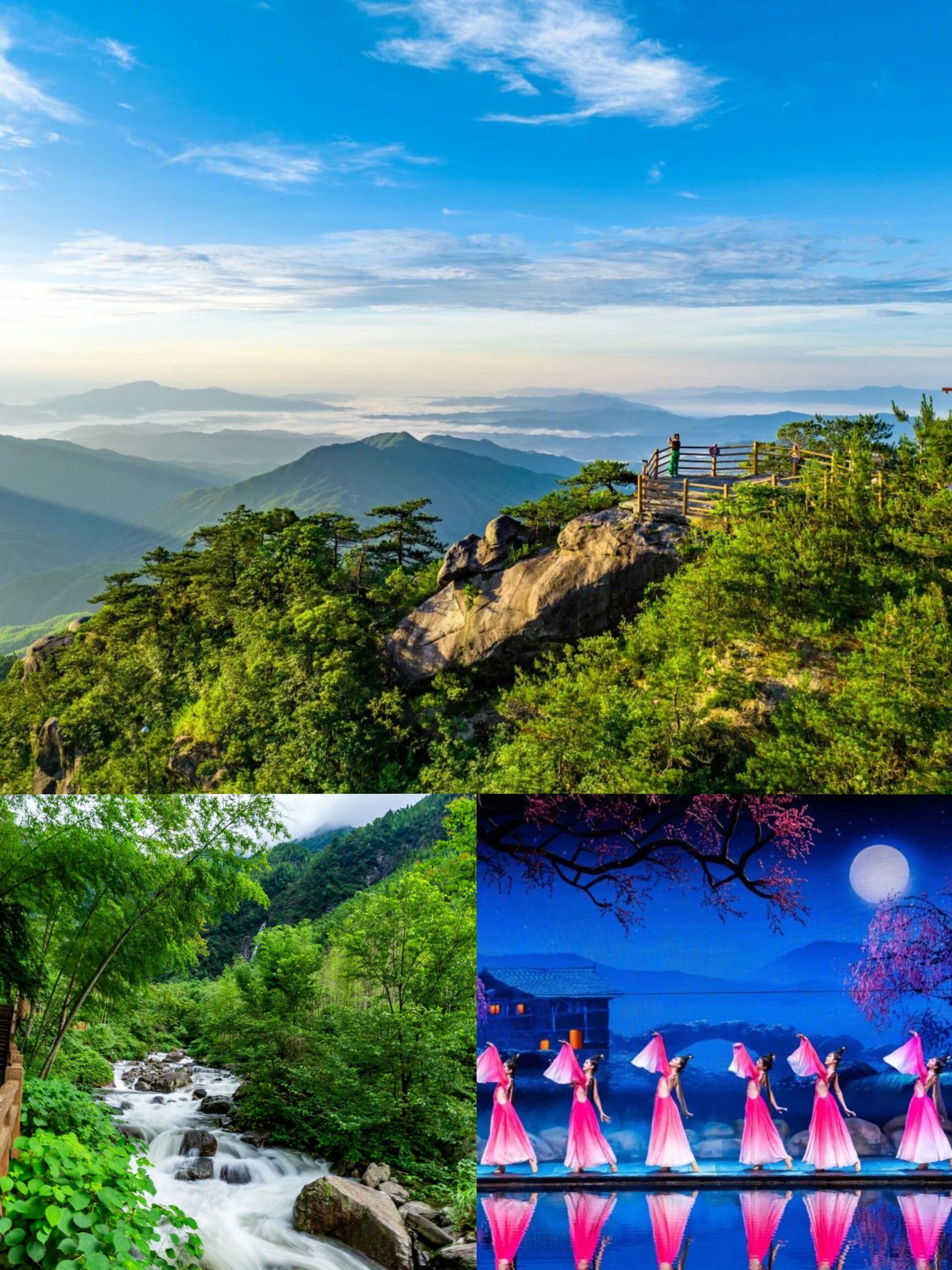
Mingyue Mountain.
Whether you seek adventure on the rugged trails, tranquility by the lakeside, or a connection with ancient traditions, Mingyue Mountain has something for everyone. This essential guide will equip you with all the information you need to make the most of your visit to this extraordinary destination.
The Rich History and Legends of Mingyue Mountain
Discovering the History and Legends of Mingyue Mountain
Nestled in Jiangxi Province, Mingyue Mountain (宜春明月山) is not only a breathtaking natural landscape but also a site steeped in rich history and captivating legends. This majestic mountain, with its semicircular shape resembling a half-moon, has long been a source of inspiration and reverence, drawing travelers and pilgrims alike.
A Brief Historical Overview
Mingyue Mountain’s history is as layered as its geological formations. It has been celebrated as a national scenic area and a national AAAAA-level tourist attraction, reflecting its importance in China’s cultural and natural heritage. The area boasts a remarkable ecological environment, recognized as a national forest park and a national natural heritage site. The mountain’s heights, particularly the towering Taiping Mountain at 1,735.6 meters, have served as a vantage point throughout history.
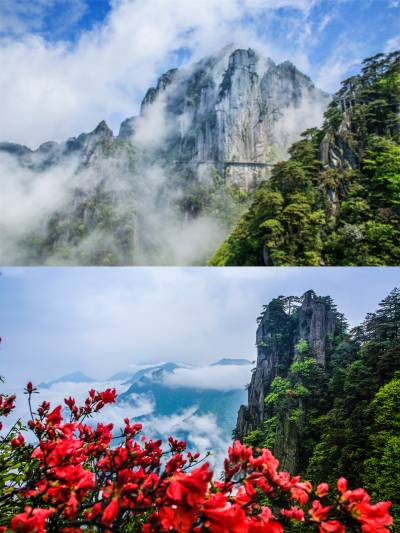
Mingyue Mountain.
The region has been adorned with temples and religious sites for centuries, playing a crucial role in the spiritual life of local communities. Mingyue Mountain is a significant destination for both Buddhism and Taoism, evidenced by the numerous historical structures that dot its landscape. These religious sites not only serve as places of worship but also as historical markers, chronicling the evolution of spiritual practices in the area.
Legends that Enrich the Mountain’s Aura
The legends surrounding Mingyue Mountain add an enchanting layer to its allure. One of the most famous tales is that of Chang’e, the Moon Goddess, who is said to have flown to the moon from this very mountain. According to folklore, the Moon Lake at the summit, with its serene waters and breathtaking views, was once the retreat of Chang’e as she ascended to the heavens. Visitors are often captivated by the romantic notion of this celestial journey, which enhances the magical atmosphere of the lake.
Another legend speaks of the Xingyue Cave, a natural formation where moonlight beams through, illuminating the interior like daylight. It is said that this cave was a hideaway for ancient scholars and poets, who sought inspiration from the ethereal beauty surrounding them. The cave’s name, which translates to “Star-Moon Cave,” reflects the mystical ambiance created by its unique geological features.
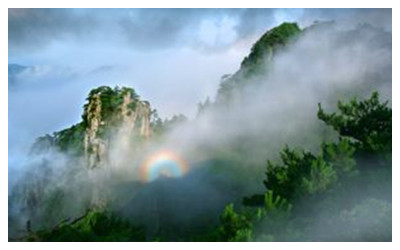
Mingyue Mountain.
Cultural Significance
Mingyue Mountain is not merely a geographical landmark; it symbolizes a confluence of nature and spirituality. The mountain is home to Buddhist and Taoist temples, many of which date back to the Tang and Song Dynasties. These temples, such as the Mingyue Temple located at the summit, serve as pilgrimage sites where visitors can engage in spiritual reflection and connect with the rich traditions of Chinese culture.
The surrounding hot springs, especially the selenium-rich Wentang Hot Spring, are said to have healing properties and have been revered for over 2,000 years. This adds another dimension to the mountain’s historical narrative, as it has been a destination for those seeking physical rejuvenation and spiritual solace.
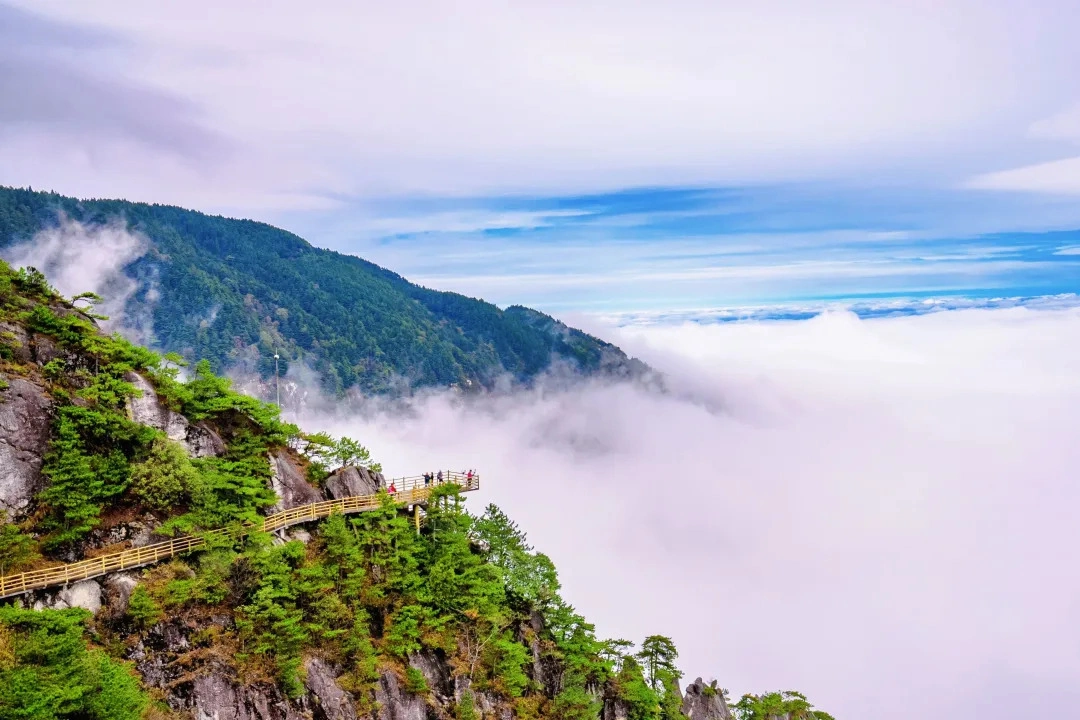
Mingyue Mountain.
Visiting Mingyue Mountain Today
Today, Mingyue Mountain continues to attract both domestic and international travelers, eager to explore its natural beauty and historical significance. The Qingyun Trail, one of the most exhilarating hiking experiences in China, offers visitors a chance to connect with the mountain’s stunning landscapes while immersing themselves in its rich history. As you traverse the trails, take a moment to ponder the legends and stories that have shaped this revered site.
In conclusion, Mingyue Mountain stands not only as a testament to China’s natural beauty but also as a living tapestry of history and legend. Whether you are drawn by its scenic vistas, spiritual sites, or the enchanting tales of old, this mountain promises an unforgettable journey through time and culture.
Main Highlights: What You Absolutely Can’t Miss
Discover the Wonders of Mingyue Mountain
Mingyue Mountain (宜春明月山) is a breathtaking destination nestled in Jiangxi Province, renowned for its stunning landscapes, rich cultural history, and unique geological features. For international travelers eager to delve into the beauty and heritage of China, this national AAAAA-level tourist attraction offers a plethora of experiences that are simply unmissable. Here’s a guide to the main highlights that will make your visit to Mingyue Mountain unforgettable.
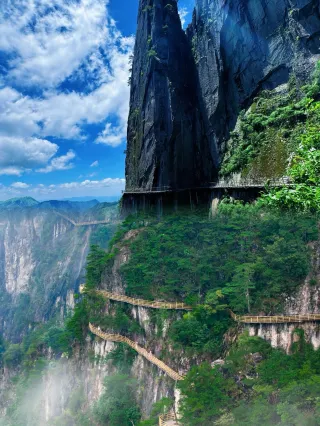
Mingyue Mountain.
1. The Majestic Qingyun Trail
One of the crown jewels of Mingyue Mountain is the Qingyun Trail, a thrilling suspended pathway that stretches approximately 3,100 meters at an elevation of around 1,500 meters. This trail, known as one of the most dangerous in China, presents an exhilarating trek with breathtaking views of the surrounding forests and mountains. The trail also features sections with transparent glass walkways, offering a unique perspective of the landscape beneath your feet. Starting from Mengyue Villa and concluding at Moon Lake, the Qingyun Trail perfectly blends adventure with natural beauty.
2. Xingyue Cave: Nature’s Enchantment
Xingyue Cave is a must-visit marvel located high up the mountain. Spanning about 150 meters, this naturally formed cave enchants visitors with its ethereal ambiance, where moonlight and starlight create a magical glow. The cave maintains a comfortable climate throughout the year, providing a tranquil escape from the outside world. As you navigate through its winding paths, you’ll be treated to the soothing sounds of a babbling stream, making it an ideal spot for reflection and relaxation.
3. Moon Lake: A Romantic Retreat
At an altitude of 1,530 meters lies Moon Lake, a serene body of water shaped like a crescent moon. Surrounded by majestic peaks, this picturesque lake offers a peaceful environment perfect for leisurely strolls along its banks. According to local legend, it was here that the moon goddess Chang’e ascended to the heavens, adding a touch of romance to the scenery. Whether you’re capturing photographs or simply breathing in the fresh mountain air, Moon Lake is an enchanting highlight of Mingyue Mountain.
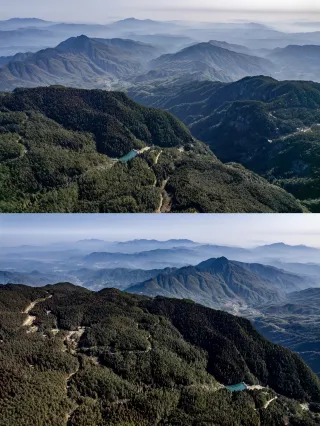
Mingyue Mountain.
4. Shanyungu Flying Waterfall: Nature’s Power
The Shanyungu Flying Waterfall is one of the tallest waterfalls south of the Yangtze River, cascading from a height of 119.57 meters. Its name reflects the awe-inspiring sight as it appears to emerge from the clouds, creating a dramatic spectacle. The steep cliffs surrounding the waterfall are adorned with inscriptions that celebrate its beauty. Visitors flock here to witness the powerful rush of water and to absorb the surrounding lush landscapes, making it a perfect spot for nature lovers and photographers alike.
5. Rich Hot Springs Experience
After exploring the mountainous terrain, unwind in the rejuvenating waters of the Wentang Hot Spring. Renowned for its selenium-rich mineral content and a history spanning over 2,000 years, these hot springs offer a unique relaxation experience amidst the natural beauty of Mingyue Mountain. Various resorts in the area provide luxurious bathing facilities, allowing visitors to enjoy the health benefits while soaking in the serene surroundings.

Mingyue Mountain.
6. Cultural Immersion: Temples and Traditions
Mingyue Mountain is also steeped in spiritual significance, with numerous Buddhist and Taoist temples dotting the landscape. These sacred sites not only offer insight into the rich religious history of the region but also provide serene spaces for contemplation and prayer. Engaging with the local culture and spiritual practices can enhance your understanding of the area’s historical context and its significance within Chinese tradition.
Final Tips for Your Journey
- Respect Nature: Maintain the beauty of Mingyue Mountain by adhering to the guidelines set for visitors. Littering and damaging vegetation is strongly discouraged.
- Weather Preparedness: The mountain weather can be unpredictable. Bring appropriate clothing and gear to stay comfortable throughout your visit.
- Take Your Time: Whether hiking the trails, exploring the caves, or relaxing by the lake, take the time to savor each moment. Mingyue Mountain is a place to connect with nature and enrich your spirit.
Mingyue Mountain promises a captivating blend of adventure, tranquility, and cultural richness. As you traverse its peaks and valleys, you’ll discover not just the beauty of the landscape, but also the depth of China’s historical and cultural tapestry.
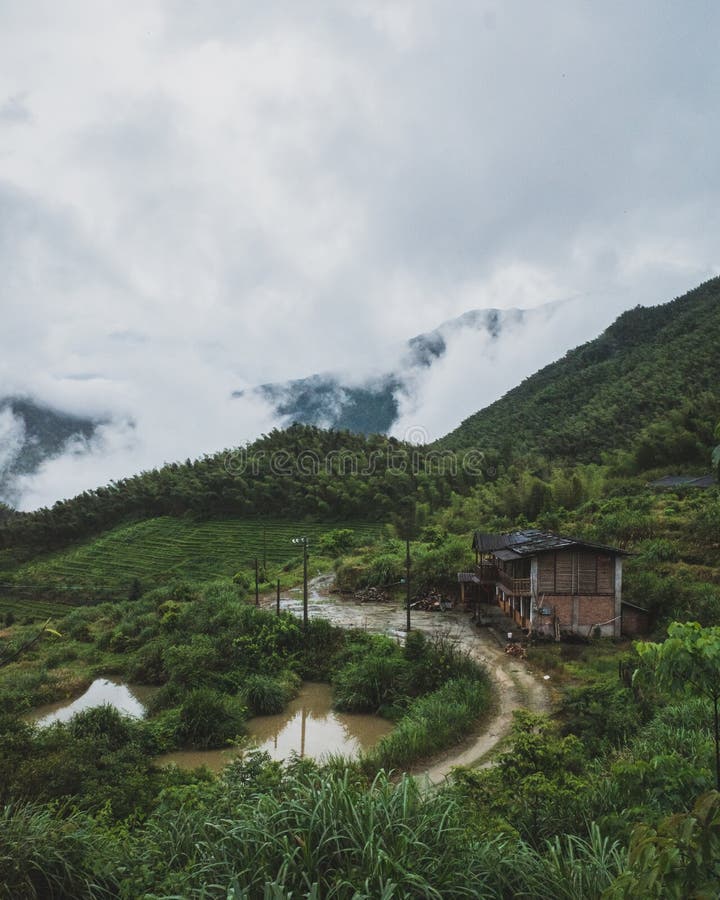
Mingyue Mountain.
Planning Your Visit: A Practical Guide
Your Essential Guide to Visiting Mingyue Mountain
Embarking on a journey to Mingyue Mountain (宜春明月山旅游区) offers an extraordinary experience steeped in natural beauty, rich cultural heritage, and exhilarating adventures. Whether you’re drawn to its breathtaking landscapes, historical significance, or the soothing embrace of its hot springs, this guide will ensure a seamless visit.
Getting There
Location: Mingyue Mountain is situated in Yichun City, Jiangxi Province, China.

Mingyue Mountain.
Transportation Options:
– By Plane: The nearest airport is Yichun Mingyue Airport, approximately 30 kilometers from the scenic area. From there, you can take a taxi or arrange for a shuttle service.
– By Train: Yichun Railway Station serves various cities in China. From the station, local buses or taxis can take you to Mingyue Mountain.
– By Car: If you’re driving, follow the G60 highway, which offers easy access to the area. Parking is available near the entrance.
Best Time to Visit
Mingyue Mountain is a year-round destination, but the ideal time to visit is during spring (March to May) and autumn (September to November). These seasons offer pleasant weather and stunning views of blooming flora and autumn foliage. Be prepared for sudden weather changes, as the mountain’s climate can be unpredictable.

Mingyue Mountain.
Entry Information
- Ticket Prices:
- General admission: 95 Yuan (discount available for early bookings)
- Mountain sightseeing car: 10 Yuan (one-way)
- Ropeway: 80 Yuan (up), 70 Yuan (down)
- Opening Hours:
- Peak Season: 07:00 – 19:00
- Off-Season: 09:00 – 17:00
Accommodation
While there are no hotels directly within the scenic area, numerous options are available in nearby Yichun City. Consider these recommended accommodations:
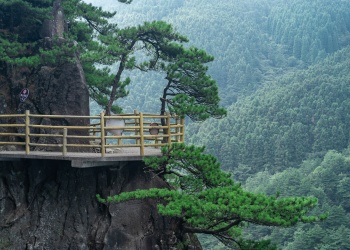
Mingyue Mountain.
- Yichun International Hotel: Offers modern amenities and is conveniently located.
- Mingyue Mountain Resort: A serene option close to the mountain, ideal for relaxation after a day of exploration.
Dining Options
Indulge in local cuisine at various eateries near the mountain. Don’t miss sampling Jiangxi rice noodles and hot pot, which are local favorites. If you’re looking for a quick bite, street vendors often offer delicious snacks like fried dumplings and grilled skewers.
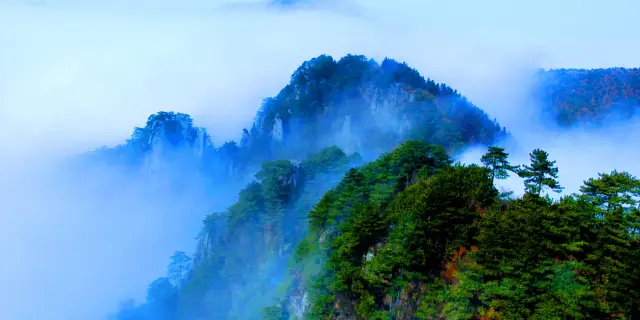
Mingyue Mountain.
Must-See Attractions
- Qingyun Trail: A thrilling suspended trail with breathtaking views. This 3,100-meter pathway provides a unique perspective of the lush forests and distant mountains.
- Xingyue Cave: A natural cave that offers a mystical experience with its year-round temperate climate and beautiful rock formations.
- Moon Lake: A picturesque, crescent-shaped lake perfect for leisurely walks and relaxation, steeped in local legends.
- Shanyungu Flying Waterfall: The highest waterfall south of the Yangtze River, offering a spectacular sight year-round.
Activities and Experiences
- Hiking: Numerous trails cater to all skill levels, from casual walks to challenging hikes. Don’t forget to wear sturdy shoes!
- Hot Springs: After a day of exploration, unwind in the Wentang Hot Spring, known for its selenium-rich waters and relaxing ambiance.
- Cultural Exploration: Visit nearby religious sites to gain insight into local Buddhist and Taoist practices.
Practical Tips
- Safety First: Always adhere to local guidelines, particularly on trails and near waterfalls.
- Respect Nature: Carry out any trash and avoid disrupting the delicate ecosystem.
- Pack Accordingly: Bring layers to adapt to temperature fluctuations, and don’t forget your camera to capture the stunning scenery!
Conclusion
A visit to Mingyue Mountain is more than just a trip; it’s an immersion into the heart of China’s natural beauty and cultural depth. Whether you’re hiking its trails, enjoying its hot springs, or simply soaking in the serene landscapes, this destination promises a memorable experience that resonates long after your journey ends. Prepare well, and let the magic of Mingyue Mountain unfold before you!
Tickets: Prices, Booking, and Tips
When planning your visit to Mingyue Mountain, it’s crucial to understand the ticketing system, prices, and some essential tips for a seamless experience. Here’s everything you need to know to make the most of your trip.
Ticket Information
Admission Prices:
– General Admission Ticket: ¥95
– Advance Booking Discount: ¥90 (available when booked one day in advance)
– Mountain Sightseeing Car:
– One-way: ¥10
– Round-trip: ¥15
– Small Train Ride:
– One-way: ¥50
– Round-trip: ¥100
– Ropeway:
– Up: ¥80
– Down: ¥70
These ticket options allow you to tailor your experience based on how much you wish to explore the scenic area.
Opening Hours
- Peak Season: 07:00 AM – 07:00 PM
- Off-Season: 09:00 AM – 05:00 PM
Booking Tips
- Advance Booking: To take advantage of the discounted price, it is advisable to book your general admission ticket a day in advance. This can typically be done through various travel apps or the official Mingyue Mountain website.
- Plan Your Route: Depending on your physical fitness and interest, you can choose to hike, take the cable car, or ride the small train. If you’re looking to conserve energy while still soaking in the breathtaking views, opt for the cable car.
Practical Tips for Visitors
- Stay Safe: Always adhere to the rules laid out by the scenic area. Pay special attention to your safety when climbing peaks or near waterfalls. It’s advisable to refrain from climbing or wading into areas that are not designated for visitors.
- Protect the Environment: Help preserve the natural beauty of Mingyue Mountain by avoiding littering and respecting the flora and fauna. Your cooperation ensures that future visitors can enjoy this stunning landscape.
- Be Weather-Ready: The weather can change rapidly at Mingyue Mountain. Check the forecast before your visit and pack rain gear and warm clothes to prepare for any sudden changes.
Unique Experiences
- Hot Springs: After a day of exploration, consider indulging in the nearby hot springs, known for their rejuvenating properties. This is a perfect way to unwind after hiking and sightseeing.
- Cultural Exploration: Don’t miss the chance to visit local Buddhist and Taoist temples scattered throughout the area, providing insight into the rich history and cultural heritage of Mingyue Mountain.
With this information in hand, you’re well on your way to experiencing the natural beauty and cultural depth of Mingyue Mountain. Enjoy your journey!
How to Get There: A Complete Transportation Guide
Getting to Mingyue Mountain: Your Ultimate Transportation Guide
Mingyue Mountain, renowned for its breathtaking natural beauty and rich cultural heritage, is a must-visit destination for travelers seeking an authentic experience in China. Nestled in Jiangxi Province, reaching this scenic area requires some planning, but the journey rewards you with stunning landscapes and historical insights. Here’s how to navigate your way to this magnificent locale.
Arriving in Jiangxi Province
-
By Air
The nearest major airport to Mingyue Mountain is Yichun Mingyue Mountain Airport (YIC), which provides domestic flights from major cities like Beijing, Shanghai, and Guangzhou. Upon arrival, you can hire a taxi or use a ridesharing app to reach the mountain area. -
Alternative Airports: If you cannot find a direct flight to Yichun, consider flying into Nanchang Changbei International Airport (KHN), which is about 200 kilometers away. From Nanchang, you can take a high-speed train or bus to Yichun.
-
By Train
Yichun is well-connected by rail, making it easy to reach via China’s extensive train network. - High-speed Trains: Take a high-speed train from major cities like Nanchang, Shanghai, or Guangzhou to Yichun Railway Station. This option is not only efficient but also offers a glimpse of the beautiful countryside.
-
Regular Trains: For a more budget-friendly option, regular trains are available, though they take longer.
-
By Bus
Buses are a popular means of transportation within Jiangxi Province. - Local Buses: From Yichun’s main bus station, you can find frequent buses heading to the Mingyue Mountain Scenic Area. The journey usually takes around 30-40 minutes.
- Intercity Buses: If you’re coming from neighboring cities, look for intercity buses to Yichun, which will connect you to local transportation options.
Getting to Mingyue Mountain Scenic Area
Once you arrive in Yichun, there are several ways to make your way to the Mingyue Mountain Scenic Area:
-
Taxi/Rideshare
The easiest and most convenient option is to take a taxi or use ridesharing services like Didi. The ride from Yichun city center to the scenic area typically takes about 30 minutes. -
Public Bus
For a more economical choice, public buses operate between Yichun and the Mingyue Mountain Scenic Area. Look for the buses marked for “Mingyue Mountain” at the bus station. These buses run regularly throughout the day. -
Guided Tours
Many travel agencies offer guided tours that include transportation to and from Mingyue Mountain. This can be an excellent way to ensure a hassle-free experience, as the guides can provide insights into the area’s history and culture along the way.
Transportation Within Mingyue Mountain
Once you arrive at Mingyue Mountain, you will find several transportation options to help you explore the scenic area:
-
Sightseeing Cars: The scenic area offers electric sightseeing cars that can take you to various attractions, including the Qingyun Trail and Moon Lake. These are especially convenient if you wish to save energy for hiking.
-
Cable Cars: For those looking to enjoy breathtaking views without the strenuous climb, cable cars are available to take you to higher altitudes, making it easier to access various trails and viewpoints.
-
Hiking Trails: If you’re up for an adventure, the mountain features well-maintained hiking trails. Remember to wear appropriate footwear and stay hydrated!
Travel Tips
-
Weather Preparedness: The climate at Mingyue Mountain can be unpredictable. Check the weather forecast before your visit and pack accordingly, including rain gear and warm clothing.
-
Safety First: While exploring, adhere to park regulations and prioritize your safety, especially on the Qingyun Trail and near waterfalls.
-
Respect the Environment: Be mindful of the natural surroundings by avoiding littering and respecting wildlife habitats.
With this comprehensive transportation guide, you’re well-equipped to embark on your journey to Mingyue Mountain. Embrace the historical and cultural treasures of this stunning destination, and enjoy the adventure that awaits you!
Local Cuisine and Accommodation Nearby
Savoring Flavors and Finding Comfort Near Mingyue Mountain
Visiting Mingyue Mountain is not only a feast for the eyes but also an opportunity to indulge in the local cuisine and enjoy comfortable accommodations that reflect the essence of Jiangxi province’s culture. Here’s a guide to some must-try dishes and the best places to stay during your visit.
Local Cuisine
1. Jiangxi Rice Noodles (江西米粉)
One of the most popular dishes in the region, Jiangxi rice noodles are known for their soft texture and ability to absorb flavors. Served in a savory broth with various toppings such as marinated meats, vegetables, and spices, this dish is a comforting meal after a day of exploring.
2. Fish Head Casserole (鱼头煲)
A specialty of Jiangxi, this dish features a fresh fish head simmered with tofu, mushrooms, and fragrant herbs in a rich broth. The combination of flavors makes it a hearty choice, perfect for sharing with friends or family.
3. Gan Guo (干锅)
This dry pot dish is a local favorite, featuring a medley of vegetables, meats, and spices, all cooked together in a hot pot. The ingredients are stir-fried at high heat, giving them a smoky flavor. It’s an excellent option for those looking to experience the bold flavors of Jiangxi.
4. Steamed Bamboo Shoots (蒸竹笋)
Fresh bamboo shoots are a seasonal delight, often steamed and served with a drizzle of soy sauce. Their crunchy texture and subtle flavor make them a refreshing side dish, highlighting the region’s agricultural bounty.
5. Wentang Hot Springs Tea (温汤温泉茶)
After indulging in the local dishes, unwind with a cup of Wentang hot springs tea, infused with the minerals from the area’s renowned hot springs. This tea is not only soothing but also believed to have health benefits.
Accommodation Options
1. Mingyue Mountain Resort (明月山度假酒店)
Nestled in the scenic area, this resort offers luxurious rooms with stunning mountain views. With amenities like a spa, hot springs, and fine dining options, it’s an ideal place to relax after a day of adventure.
2. Wentang Hot Springs Hotel (温汤温泉酒店)
This hotel is famous for its natural hot spring baths. Guests can enjoy thermal pools and wellness treatments while soaking in the tranquil atmosphere. The hotel also serves local cuisine, allowing you to savor flavors from your room.
3. Yichun Jinjiang International Hotel (宜春锦江国际酒店)
Located a short drive from Mingyue Mountain, this hotel features modern accommodations, a fitness center, and a restaurant serving both Western and Chinese dishes. It’s a convenient base for exploring the region.
4. Huasheng Hotel (华盛酒店)
Offering budget-friendly rates without compromising on comfort, this hotel is known for its friendly staff and clean rooms. Its proximity to local eateries makes it a great spot for travelers looking to experience the local dining scene.
5. Eco-Friendly Guesthouses
For a more immersive experience, consider staying at one of the eco-friendly guesthouses in the area. These charming accommodations often feature local decor and home-cooked meals, providing a unique opportunity to engage with the culture and hospitality of Jiangxi.
Final Thoughts
As you explore the breathtaking landscapes of Mingyue Mountain, take the time to indulge in the delightful local cuisine and find the perfect accommodation that suits your travel style. Whether you opt for luxury or a cozy guesthouse, the flavors and comforts of Jiangxi will surely enrich your travel experience.
Frequently Asked Questions
Frequently Asked Questions about Mingyue Mountain
1. What are the main attractions in the Mingyue Mountain Scenic Area?
Mingyue Mountain is renowned for several stunning attractions, including:
– Qingyun Trail: A thrilling suspended trail offering breathtaking views.
– Xingyue Cave: A naturally formed cave with a magical atmosphere.
– Moon Lake: A picturesque lake surrounded by majestic mountains.
– Shanyungu Flying Waterfall: The highest waterfall south of the Yangtze River, known for its stunning drop and misty ambiance.
2. What is the best time to visit Mingyue Mountain?
The scenic area can be visited year-round, but the best times are during spring (April to June) and autumn (September to November). During these seasons, the weather is mild, and the natural scenery is particularly vibrant.
3. How can I reach Mingyue Mountain?
Mingyue Mountain is located in Yichun City, Jiangxi Province. The nearest major cities with transportation links are Nanchang and Jingdezhen. From these cities, you can take a bus or hire a taxi to Yichun and then use local transport to reach the mountain.
4. Are there accommodations available near Mingyue Mountain?
Yes, there are various accommodations ranging from budget hostels to mid-range hotels and luxury resorts nearby. Some hot spring resorts also offer unique experiences, allowing visitors to relax after exploring the mountain.
5. What should I wear while visiting Mingyue Mountain?
Comfortable hiking shoes are essential for navigating the trails. Dress in layers, as the weather can change rapidly, especially at higher altitudes. Don’t forget a hat and sunscreen for sun protection, and bring a raincoat if rain is in the forecast.
6. Are there any safety precautions I should take?
Yes, safety is paramount. Always stay on marked trails, especially on the Qingyun Trail, which can be challenging. Be cautious when near waterfalls and steep cliffs. Additionally, respect the environment by not littering and avoiding damage to plants and wildlife.
7. Can I experience the local culture while visiting?
Absolutely! Mingyue Mountain is rich in religious culture, home to numerous Buddhist and Taoist sites. Visitors can explore temples and learn about the local history and traditions. Additionally, the hot springs in the area are a fantastic way to relax and experience a traditional Chinese spa.
8. Is there an entrance fee for Mingyue Mountain?
Yes, the entrance fee is generally around 95 yuan, with discounts available for advance bookings. Additional costs may include fees for the mountain sightseeing car, cable car rides, and other attractions within the scenic area. Always check for the latest prices and opening hours before your visit.
Final Thoughts on Your Trip
As your journey through the enchanting landscape of Mingyue Mountain draws to a close, take a moment to reflect on the myriad experiences that this stunning region has offered. Nestled in the heart of Jiangxi Province, this natural wonder combines breathtaking scenery with a rich tapestry of history and culture, making it an essential destination for anyone interested in China’s diverse heritage.
A Journey of Discovery
From the exhilarating heights of the Qingyun Trail to the serene beauty of Moon Lake, each step along the way has been an invitation to explore not just the stunning vistas, but also the fascinating stories that have shaped this area. The Xingyue Cave, with its ethereal ambiance, and the majestic Shanyungu Flying Waterfall, cascading like a silver ribbon from the clouds, have surely left an indelible mark on your memory.
Embrace the Essence of Mingyue Mountain
Mingyue Mountain is more than a scenic destination; it is a sanctuary that nurtures the spirit. Whether you took the time to soak in the healing waters of the Wentang Hot Spring or marveled at the intricate details of the local Buddhist and Taoist temples, each moment spent here contributes to a deeper understanding of the harmony between nature and culture.
Final Reflections
As you prepare to leave, consider how the tranquility and beauty of Mingyue Mountain will linger in your thoughts, inspiring future adventures and a greater appreciation for the natural world. We hope your journey has not only been a feast for the senses but also a profound exploration of the history and culture that define this remarkable region.
May your travels bring you back to the breathtaking landscapes and rich traditions of China, where every mountain holds a story, and every journey is a new chapter waiting to unfold. Safe travels!